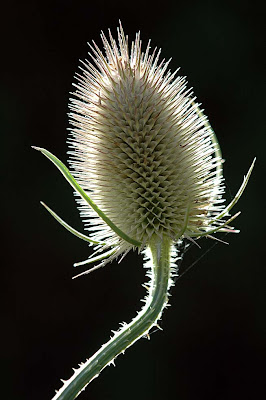Tuesday, September 8, 2009
A Poke in the Eye from a Teasel
The teasels Dipsacus fullonum in my garden are beginning to shed ripe seeds, so I’m expecting the local goldfinches to show up any day now. This species’ liking for teasel seeds is legendary and I read recently that it’s only the males, which have more slender beaks than females, that can reach the seeds (see http://www.arkive.org/goldfinch/carduelis-carduelis/info.html). Can this really be true? If so, why does this sexual difference in goldfinch beak shape exist? The forest of spines on the teasel seed heads is surely a defence mechanism that has evolved to keep hungry birds at bay, by poking them in the eye, so it might be expected that natural selection, which operates to preserve features that enhance the fitness (reproductive potential) of a species would ultimately favour the evolution of teasel heads with longer spines, which would force even the slender-billed male goldfinches to keep their distance. Interestingly, plant breeders at the International Centre for Research in the Semi-Arid Tropics in India have been breeding pearl millet varieties with extra-long bristles in their seed heads for just this purpose – for keeping flocks of finches at bay by irritating their eyes and beaks when they try to eat the grain (see http://www.new-ag.info/98-1/focuson.html)

Very interesting. I had no idea about the beaks or the breading of new varieties of teasel. I love to learn new things. Thanks.
ReplyDeleteThat is a stunning picture Phil; backlit on black background, perfect.
ReplyDeleteInteresting about the beak size for telling the sexes apart. Not heard that before.
Something else I never knew! I've just looked this up in the New Naturalist volume about finches which confirms that the males are slightly larger birds than the females and have a bill about 10% longer (about a millimetre or two). Females, as a result, prefer other plants than teasels which they find hard to reach.
ReplyDeleteThe graded variations in bill design of all the finches in Europe, from the crunchers of the hawfinch to the tweezers of the goldfinch means that no two species have exactly the same feeding preferences and the group as a whole neatly divides out the available seed types.
A further split then occurs within some species, like the goldfinch, between males and females. Maybe there is an advantage here in that if the 2 parents are able to utilise a broader range of seeds between them they have a better chance of feeding their young if one type of plant has a bad year??
Incidentally, I see that man Darwin was on the case again, observing this feeding difference in 1857!
As for the teasel - well it hasn't caught up with the goldfinch yet I suppose - evolutionary work in progress.....
Very interesting Phil. I must nip down the road and grab some seeds from the Teasel growing there before Mr Goldfinch eats them all. If I can get some to grow in the garden maybe next year I can take some video of the local Goldfinches at work.
ReplyDeleteHi Squirrel, The difference in beak size was new to me too. The breeding for bird resistance using the long bristles is in pearl millet, rather than thistles, but the principle is the same!
ReplyDeleteHi Keith, It just happened to be backlit by the setting sun, with a dark hedge behind. I planted some teasel seed abot 20 years ago and they've been seeding themselves around the garden ever since - so the goldfinches don't get all the seeds.
ReplyDeleteHi John,I've found that all sorts of small insects hibernate in the empty seed compartments in the seed head - they seem to be a favourite winter haunt of some of the smaller species of bee.
ReplyDeleteFascinating stuff, Nyctalus, I had no idea that Darwin had been on the goldfinchs' case back in 1857... he didn't miss much, did he?
ReplyDelete